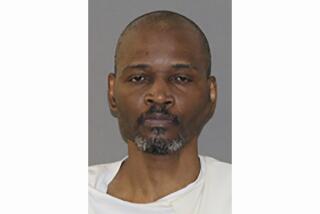Charges filed in 1994 shooting
- Share via
It was 1:30 a.m. on a July morning in 1994. On 5th and Crocker streets in the heart of skid row, a woman nicknamed “Chocolate” was slinging dope.
Another skid row denizen, Markie Anderson, wanted to sell her a bicycle.
It was never really clear what caused their fight. But it ended when Chocolate, whose real name is Shelia Burton, shot Anderson in the back as he ran down the street.
Burton was convicted of assault and sentenced to five years in prison. And Anderson was left a paraplegic in a wheelchair.
But in recent years they remained homeless, sharing the streets of skid row. “They were assailant and victim still living in close proximity to each other with no apparent problems,” Los Angeles Police Lt. Paul Vernon said.
Until recently.
Anderson died. And after the L.A. County coroner’s office listed the cause of death as that shooting 13 years ago, police arrested Burton on Thursday. Prosecutors charged Burton with murder in Anderson’s death -- despite the long lag time.
Anderson had been living in the southern part of downtown, hanging out at times with his sister, who might also be homeless. Sometimes, he found refuge in homeless shelters but often was seen wheeling himself down the streets, searching for a place to sleep at night.
Last month, police said, Anderson went to a hospital complaining of dizziness and stomach pain. He died at California Hospital Medical Center on Sept. 20 at age 44.
“The coroner conducted an autopsy and determined it to be a homicide. The gunshot wound that crippled him 13 years earlier cut short his life,” Vernon said.
Police received an arrest warrant and asked LAPD Officer Deon Joseph, a skid row senior lead officer who knows the row regulars, to find Burton. A few inquiries later and police arrested Burton, 45, at San Julian Park, a block or so away from where she and Anderson met on that fateful morning in 1994. Burton, according to police, seemed puzzled by the detectives’ interest in her as they told her Anderson was dead.
With indignation, she declared that she already had served time in prison for that crime, Vernon said. Detectives explained that she had served time for assault, but with Anderson’s death, it was now a homicide, as if Burton had shot Anderson dead that July morning.
Joseph described Burton as a fixture of skid row who police believed was a major drug dealer there. Burton had been convicted at least twice of drug dealing, according to court records.
“She’s at the top of the pyramid in terms of dealing drugs in the park here,” said Joseph, adding that he believed she often made enough money to live elsewhere but always returned to skid row.
Professor Robert Pugsley, who teaches criminal law at Southwestern Law School, said the charges against Burton were highly unusual but legally sound. “Because it is a separate, more serious offense, it is not considered double jeopardy -- that is seeking to punish someone for the same crime,” he said. “If the coroner decided there is a causal connection between the shooting and the death, a murder can be charged.”
Pugsley said that if the case goes to trial, the coroner will face heavy scrutiny over whether a shooting 13 years ago was the direct cause of death.
For skid row detectives, the case was a reminder of how violent skid row once was. The area has been in the midst of a police crackdown that has resulted in a major decline in crime. “One thing has changed since that time: There are far fewer guns on skid row now than before,” Vernon said.
Because Anderson died this year, his death will be added to the skid row homicide numbers for 2007, bringing the total to five.
--
More to Read
Sign up for Essential California
The most important California stories and recommendations in your inbox every morning.
You may occasionally receive promotional content from the Los Angeles Times.












